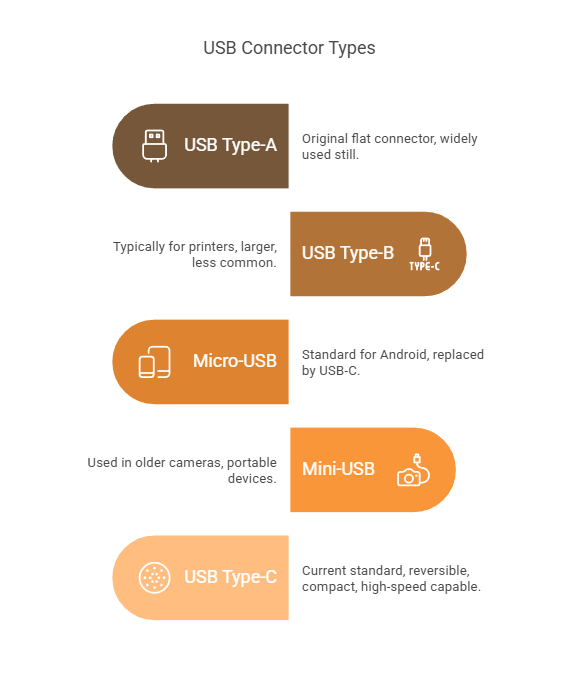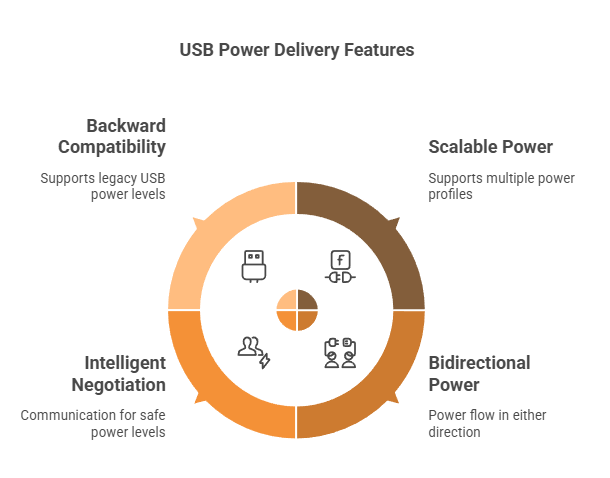What You Need to Know
About USB
The Universal Serial Bus – commonly known as USB – is a foundational technology that underpins modern digital connectivity. While it often goes unnoticed, USB plays a critical role in our daily interactions with devices, enabling data transfer, power delivery, and peripheral connectivity across a wide range of hardware.
Despite its ubiquity, many users find USB standards confusing due to evolving specifications, varying connector types, and inconsistent nomenclature.
This article offers a clear, professional overview of USB technology, its components, limitations, and what to consider when selecting USB-compatible devices or accessories.
Table of Contents:
- A Brief History of USB
- Understanding the Physical Interface
- Data Transfer and Power Performance
- USB Cable Limitations
- USB and Virtual Machines
- Best Practices for Users and Professionals
A Brief History of USB
Introduced in the mid-1990s, USB was developed to streamline connectivity between computers and peripheral devices. Prior to its adoption, users had to navigate a range of specialized ports (serial, parallel, PS/2, etc.), often requiring device-specific drivers and restart sequences.
USB provided a unified interface that supported hot-swapping, plug-and-play functionality, and eventually, a standardized approach to both data transmission and power delivery. Since its inception, USB has undergone multiple revisions to improve speed, power capabilities, and compatibility.
Connector Types: Understanding the Physical Interface
USB connectors have evolved significantly, but many variations remain in use. Understanding these form factors is essential for device compatibility:
- USB Type-A: The original flat, rectangular connector, still widely used on desktops, TVs, and charging bricks.
- USB Type-B: Typically found on printers and external drives. Larger and less common today.
- Micro-USB: Once standard for Android smartphones and accessories, now largely replaced by USB-C.
- Mini-USB: Used in older digital cameras and portable devices. Rare in current products.
- USB Type-C: The current standard for modern devices. Reversible, compact, and capable of handling high-speed data, video output, and high-wattage charging.

Recommendation: When purchasing new equipment, prioritize USB-C compatibility. The industry is rapidly transitioning to this versatile standard.
USB Versions: Data Transfer and Power Performance
While the connector type defines the physical interface, the USB version determines performance. Unfortunately, the versioning and branding conventions can be misleading. Here is a concise overview:
| USB Version | Maximum Speed | Common Branding |
|---|---|---|
| USB 1.1 | 12 Mbps | Full Speed |
| USB 2.0 | 480 Mbps | High Speed |
| USB 3.0 | 5 Gbps | SuperSpeed |
| USB 3.1 | 10 Gbps | SuperSpeed+ |
| USB 3.2 | Up to 20 Gbps | Often still labeled SuperSpeed |
| USB4 | Up to 40 Gbps | Compatible with Thunderbolt 3/4 |
It is important to note that not all USB-C cables or ports offer USB4 or even USB 3.1 speeds. Always verify the specifications of both the cable and the connected devices.
USB Power Delivery: more than just charging
USB Power Delivery (USB PD) is one of the most transformative aspects of modern USB technology. Introduced alongside USB-C, USB PD enables dynamic, efficient power negotiation between connected devices, allowing higher power levels and smarter charging.

With USB Power Delivery (USB PD), USB evolved beyond simple data transfer. USB PD enables intelligent, flexible power negotiation between devices and chargers. Today, USB PD can deliver up to 240 watts - enough to power laptops, monitors, and high-performance accessories.
This innovation simplifies cable management and reduces the need for proprietary power adapters. When paired with USB-C, users can benefit from a single-cable solution for power, data, and even video.
Additional capabilities
Modern USB implementations offer several advanced features:
- USB OTG (On-The-Go): Allows supported mobile devices to act as hosts, enabling direct connection to USB drives, keyboards, and other peripherals.
- Hubs and Docking Stations: Expand a single port into multiple inputs and outputs, essential for ultrabooks and mobile workstations.
- Video Transmission: USB-C with DisplayPort Alt Mode supports video output to monitors and projectors, a common feature in professional docking solutions.
USB Cable Limitations
-
1
Length Restrictions
USB cables are limited by passive transmission lengths. High-speed or high-power configurations may require shorter cables or active solutions. -
2
Inconsistent Capabilities
Cables that appear identical may vary significantly in terms of supported data speeds, power delivery, and video compatibility. Always confirm specifications. -
3
Physical Wear
Repeated bending, poor materials, or low manufacturing standards can lead to failure. High-performance use cases demand durable, certified cables. -
4
Interoperability Issues
Not all USB-C implementations are equal. Devices and cables may support different protocols, leading to potential compatibility issues.
Did you know?
Most of USB devices can be accessed from a remote PC as if they were connected locally to yours with the help of USB over Network software.USB and Virtual Machines: A Hidden Compatibility Challenge
While USB devices integrate seamlessly with most operating systems, their use within virtual machine (VM) environments can present limitations. USB passthrough, the process of connecting a USB device to a guest VM, is not universally supported across all virtualization platforms.
Common Issues Include:
- Driver and hardware dependencies that restrict USB redirection.
- Limited bandwidth allocation, particularly in shared-host environments.
- Device type restrictions, where certain USB peripherals (e.g., dongles, cameras, external drives) may not function properly in guest systems.
- Security policies in enterprise environments disable USB device access by default within virtual machines.
Platform Variability:
Support for USB pass-through varies by platform:
- VMware Workstation and Fusion support a wide range of USB devices, though high-speed or isochronous (e.g., audio/video) devices may be unreliable.
- VirtualBox requires extension packs for full USB 2.0/3.0 support and may still exhibit limitations.
- Hyper-V, by default, has limited support for direct USB device access.
Recommendation: When planning to use USB devices within virtualized environments, first validate your VM host's USB pass-through capabilities. For enhanced flexibility and reliability, consider using a dedicated solution such as USB Network Gate, which enables remote access to USB devices across virtual machines and networked systems, bypassing many of the native virtualization limitations.
Best Practices for Users and Professionals
To maximize reliability and performance, consider the following:
- Use certified, high-quality USB cables, especially for high-wattage charging or data-intensive tasks.
- Verify version compatibility between host devices, hubs, and cables.
- Label and organize your cables to ensure efficient cable management.
- For seamless USB access in virtual machines, verify host support and consider using USB Network Gate, which bypasses common virtualization limitations.